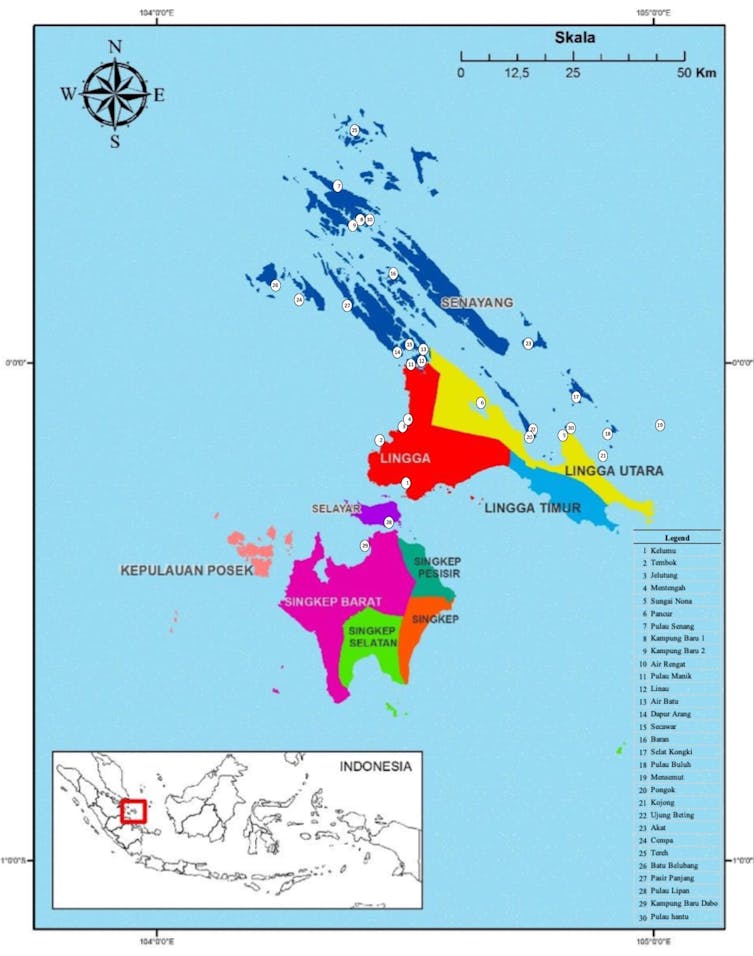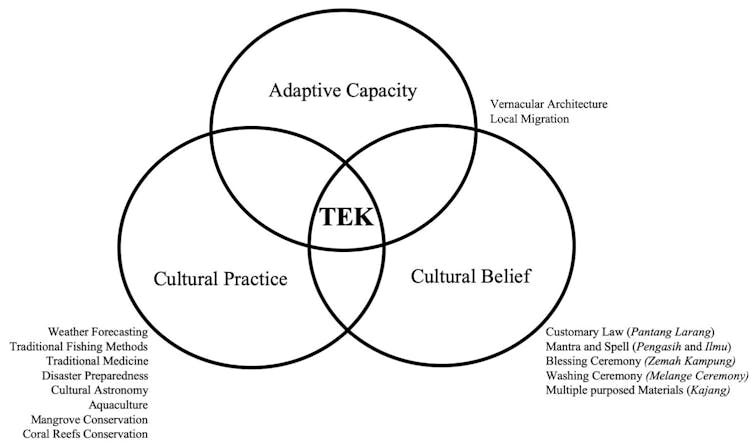Traditional knowledge helps Indigenous people adapt to climate crisis, research shows
By Wengky Ariando, PhD Student, Climate Change and Development, Chulalongkorn University
This article is part of a series to celebrate World Oceans Day on June 8.
Indigenous peoples, who make up 5% of the global population, are among the most vulnerable groups. They face issues ranging from poverty and human rights abuses to the climate crisis.
Nevertheless, Indigenous peoples contribute significantly to biodiversity conservation and sustainable natural resources management.
The do so, in both terrestrial and marine ecosystems, through their traditional knowledge. This knowledge has been handed down through generations.
My research from October 2018 to January 2019 found the traditional ecological knowledge applied by Orang Suku Laut of Lingga Regency in Riau Islands Province, Indonesia, could be adopted as ways to reduce the impacts of the climate crisis.
Orang Suku Laut and climate change
The Orang Suku Laut, an indigenous Malay people, have been living as sea people or sea nomads since the 16th century.
However, in the early 1990s, the groups divided into three types: the nomads, the semi-nomads, and the sedentary.
Currently, they mostly inhabit the east coast of the Sumatran mainland and Riau Archipelago.
The highest population of Orang Suku Laut, 30 groups, 806 households and 3,931 inhabitants, live in Lingga regency of Riau Islands province, around 1,000 kilometres from Jakarta, the capital of Indonesia.

My research analysed the interaction between cultural practice, cultural belief and adaptive capacity, or traditional ecological knowledge of Orang Suku Laut, as they struggle with impacts of the climate crisis.
Fikret Berkes, an applied ecologist from University of Manitoba, Canada, in 1993 introduced the term traditional ecological knowledge as a social science approach.
This approach, in the context of climate science, can reveal how the complex knowledge system of Indigenous peoples deal with impacts of climate crisis.
My research concluded 80.18% of Orang Suku Laut had experienced these impacts – rising temperatures affecting seasonal patterns, more diseases, water scarcity – on their lives.
Climate change adaptation by Orang Suku Laut
For hundreds of years, the Orang Suku Laut have practised a way of life that incorporates the ancestral culture and nature as the source of life.
My research divided this traditional knowledge into cultural practice, cultural belief and adaptive capacity, which underpins the tribe’s ability to adapt to climate impacts.

1) Cultural practice
The cultural practice of Orang Suku Laut is weather forecasting through natural signs, such as wind patterns, fish or bird movements, sky observations, ocean currents and temperature.
The tribe also practises a nomadic lifestyle based on the annual changes in seasons. In this way they avoid the impacts of disasters such as drought and sea storms.
The monsoon rainfall pattern heavily influences the seasonal calendar of Orang Suku Laut.
Using this pattern, they can predict North Season as the season with hydrometeorological disasters, East Season as the season with high fisheries productivity, South Season as the dry period, and West Season as the wet period.
They are still using this cultural practice, or traditional knowledge, and it’s essentially adaptable to non-Indigenous groups.
2) Cultural belief
In the theory of traditional ecological knowledge, scientists consider cultural belief, which embodies taboo and animism concepts like other well-established religions, an inseparable part of environmental management by indigenous communities.
Orang Suku Laut still observe the cultural belief called Pantang Larang, a rule passed down for generations to enforce customary law, such as a ban on cutting down trees, or catching specific fish species.
Pantang Larang is heavily linked to the tribe’s spiritual values. For the ancestors, Pantang Larang is linked with the use of magical powers, ilmu (spell) and pengasih (mantra), to reduce rain intensity and avoid storms at sea.
This cultural belief is a dynamic and reflective traditional ecological knowledge. It connects spirituality and taboo to protect nature.
3) Adaptive capacity
The adaptive capacity of Orang Suku Laut can be seen in their architecture and the practice of local migration.
The Orang Suku Laut adopt a vernacular architectural style, using local materials and traditional knowledge, for their buildings and boats.
Their stilt house, Saphaw, and rowing boat, Sampan Kajang, are made from Mentango or Bintangur wood, a hardwood tree easily found in the tropics and lowlands, such as Riau Archipelago.
The roofs and walls of the house are made of Mengkuang leaves, a variety of thorny pandanus plant that grows on the coastal shore and tropical small islands.
The architectural designs of Orang Suku Laut have been protecting them from sea storms, rising temperature and other extreme events while adopting the principles of ecological sustainability.
This is one of their adaptive capacities.
Another capacity is local migration. The tribe moves from one island to another during the northern monsoon, which usually brings massive storms.
They migrate as a way to protect themselves from droughts, high tides, extreme events and diseases and group conflicts.
This seasonal migration could serve as an indigenous-based strategy for climate change adaptation.
Recommendations and development
My research found 55% of Orang Suku Laut understand the need to integrate science and technology with their traditional ecological knowledge to adapt to climate impacts.
However, there are challenges, including declining practices of traditional beliefs, such as rituals and spells, because most have converted to new religions (Islam or Christianity).
In addition, current government policies do not pay much attention to traditional ecological knowledge, along with the state of Indigenous peoples relating to social, economic and political issues at all levels.
Nevertheless, the government can start by including this knowledge in the Indonesian Action Plan on Climate Change Adaptation as part of community-based climate adaptation.
And it can support further interdisciplinary research on Indigenous peoples and climate change.
Another recommendation is to constantly apply the principle of free, prior and informed consent in every development that involves Indigenous peoples and their lands. This would uphold their right to give, or withold, their consent for any development agenda carried out on their ancestral domains.
Policy should also aim to determine the plans suitable for customary laws and territories to achieve sustainable community-based, natural resource management.